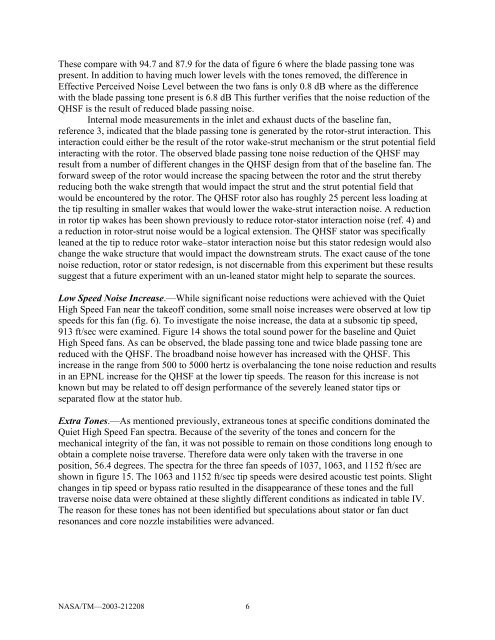The Noise of a Forward Swept Fan - CAFE Foundation
The Noise of a Forward Swept Fan - CAFE Foundation
The Noise of a Forward Swept Fan - CAFE Foundation
Create successful ePaper yourself
Turn your PDF publications into a flip-book with our unique Google optimized e-Paper software.
<strong>The</strong>se compare with 94.7 and 87.9 for the data <strong>of</strong> figure 6 where the blade passing tone waspresent. In addition to having much lower levels with the tones removed, the difference inEffective Perceived <strong>Noise</strong> Level between the two fans is only 0.8 dB where as the differencewith the blade passing tone present is 6.8 dB This further verifies that the noise reduction <strong>of</strong> theQHSF is the result <strong>of</strong> reduced blade passing noise.Internal mode measurements in the inlet and exhaust ducts <strong>of</strong> the baseline fan,reference 3, indicated that the blade passing tone is generated by the rotor-strut interaction. Thisinteraction could either be the result <strong>of</strong> the rotor wake-strut mechanism or the strut potential fieldinteracting with the rotor. <strong>The</strong> observed blade passing tone noise reduction <strong>of</strong> the QHSF mayresult from a number <strong>of</strong> different changes in the QHSF design from that <strong>of</strong> the baseline fan. <strong>The</strong>forward sweep <strong>of</strong> the rotor would increase the spacing between the rotor and the strut therebyreducing both the wake strength that would impact the strut and the strut potential field thatwould be encountered by the rotor. <strong>The</strong> QHSF rotor also has roughly 25 percent less loading atthe tip resulting in smaller wakes that would lower the wake-strut interaction noise. A reductionin rotor tip wakes has been shown previously to reduce rotor-stator interaction noise (ref. 4) anda reduction in rotor-strut noise would be a logical extension. <strong>The</strong> QHSF stator was specificallyleaned at the tip to reduce rotor wake–stator interaction noise but this stator redesign would alsochange the wake structure that would impact the downstream struts. <strong>The</strong> exact cause <strong>of</strong> the tonenoise reduction, rotor or stator redesign, is not discernable from this experiment but these resultssuggest that a future experiment with an un-leaned stator might help to separate the sources.Low Speed <strong>Noise</strong> Increase.—While significant noise reductions were achieved with the QuietHigh Speed <strong>Fan</strong> near the take<strong>of</strong>f condition, some small noise increases were observed at low tipspeeds for this fan (fig. 6). To investigate the noise increase, the data at a subsonic tip speed,913 ft/sec were examined. Figure 14 shows the total sound power for the baseline and QuietHigh Speed fans. As can be observed, the blade passing tone and twice blade passing tone arereduced with the QHSF. <strong>The</strong> broadband noise however has increased with the QHSF. Thisincrease in the range from 500 to 5000 hertz is overbalancing the tone noise reduction and resultsin an EPNL increase for the QHSF at the lower tip speeds. <strong>The</strong> reason for this increase is notknown but may be related to <strong>of</strong>f design performance <strong>of</strong> the severely leaned stator tips orseparated flow at the stator hub.Extra Tones.—As mentioned previously, extraneous tones at specific conditions dominated theQuiet High Speed <strong>Fan</strong> spectra. Because <strong>of</strong> the severity <strong>of</strong> the tones and concern for themechanical integrity <strong>of</strong> the fan, it was not possible to remain on those conditions long enough toobtain a complete noise traverse. <strong>The</strong>refore data were only taken with the traverse in oneposition, 56.4 degrees. <strong>The</strong> spectra for the three fan speeds <strong>of</strong> 1037, 1063, and 1152 ft/sec areshown in figure 15. <strong>The</strong> 1063 and 1152 ft/sec tip speeds were desired acoustic test points. Slightchanges in tip speed or bypass ratio resulted in the disappearance <strong>of</strong> these tones and the fulltraverse noise data were obtained at these slightly different conditions as indicated in table IV.<strong>The</strong> reason for these tones has not been identified but speculations about stator or fan ductresonances and core nozzle instabilities were advanced.NASA/TM—2003-212208 6

















